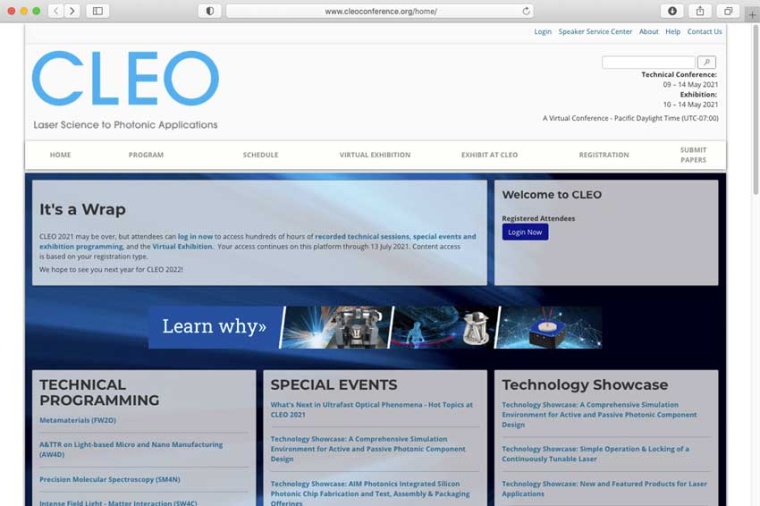“Showcasing innovative research and applications in laser science”
Review: CLEO 2021, 9 – 14 May, online only
Distinguished speakers from across the globe described advances in quantum and silicon photonics, optical imaging and sensing and more during the all-virtual CLEO 2021 held in May. The conference drew more than 4,600 registrants from 73 countries.

Ultrabroadband nanophotonics, integrated nonlinear photonics, self-driving cars, ultrafast lasers and the optics community’s response to Covid-19 were among topics for more than 2,000 technical and poster presentations across 241 technical, postdeadline papers and poster sessions, workshops, short courses and special events. Registrants have access to recorded presentations to view on-demand for sixty days.
“The virtual event expanded our knowledge of research and technologies that are driving the industry forward,” said program chair Clara Saraceno. “The extraordinary developments in areas ranging from high harmonic and fiber-based light sources to photonic computing illustrate the amazing work of researchers and industry leaders developing and bringing these products to market.”
Speakers from government, industry and academia participated in a workshop focused on biophotonics and nanophotonics optical approaches in fighting pandemics and challenges associated with those applications. Among them were UV radiation for effective decontamination and cleaning and spectroscopy techniques for rapid pathogen detection and virus probing.
“The presenters covered a wide-range of groundbreaking research that is rapidly changing our field,” said CLEO 2021 general chair Christophe Dorrer. “We are investigating our world at the fundamental level and addressing concrete problems with photonics and advanced laser science.” One presentation reviewed work underway to detect exoplanets with precision optical technology. “Small planets are very abundant in our galaxy,” said Dimitri Mawet of California Institute of Technology, USA, adding that direct imaging will enable scientists to learn more about their atmospheres.
The discovery of the supermassive black hole was the topic of a talk by Shep Doeleman of Harvard University, USA. This seminal achievement relied on optical sparse aperture systems for astronomical observations. The team used a technique called very-long-baseline interferometry (VLBI) using radio telescopes worldwide connected by a network of atomic clocks to observe the hole and digitize data, he said.
The CLEO Virtual Exhibition featured eighty leading companies in laser science and photonic applications: Toptica Photonics, AIM Photonics, OptoSigma, Coherent, MKS, Synopsis, Oz Optics, Menlo Systems and many more. (Source: OSA)











